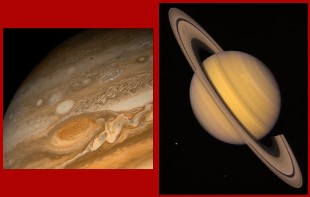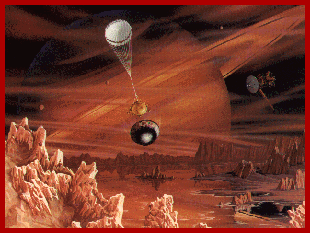Gian Domenico Cassini (continued)
 |
|
| Fig. 1:
On the
left, the great "red spot" on Jupiter, discovered by Cassini in 1665. On
the right, Saturn with its rings. The dark division on the rings,
discovered by Cassini in 1675, is called the Cassini Division. (Credit: NASA ) |
Cassini's scientific activities covered various fields of astronomy, as well as
hydraulics, art of war, entomology and even medicine – he took part in some of
the very first blood transfusion experiments.
In Bologna he accurately observed three
comets and was one of the first to suggest for these celestial bodies a strongly
elliptical circular orbit, believing them to be "recurrent" stars. This would
be proven later by Halley, based on Newton's Universal Law of Gravitation.
Cassini measured the rotation of Mars to within a 3-minute accuracy and he established the distance of Mars from Earth. He could therefore then work out the Earth-Sun distance (the basic Astronomical Unit of measurement within the solar system) with a 7% accuracy.
He also measured the rotation of Jupiter and discovered on it the "red spot", the eye of a gigantic hurricane which has raged in the planet’s atmosphere for centuries.
He discovered four satellites of Saturn and the division between the rings of the planet, known today as the Cassini Division. He sensed that the rings were not a rigid body but rather a myriad of small particles.
 |
|
| Fig. 2:
This
artist's impression shows the Huygens probe released in the atmosphere of
Titan by the Cassini spacecraft, seen on the right under the rings of
Saturn. (Credit: NASA /ESA) |
The astronomical community has remembered Cassini and all his important
discoveries by naming after him the Cassini Crater on the moon, the Cassini
Crater on Mars and the Cassini Region on the satellite of Saturn, Iapetus.
In addition, the joint NASA/ESA mission
which will explore the Saturn system in 2004 and will leave the Huygens space
probe on its largest satellite, Titan, has been named after Cassini.
|
|
